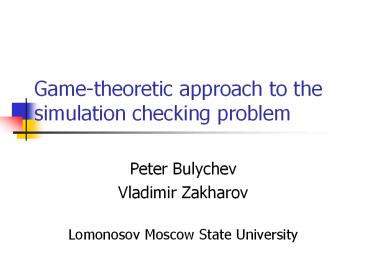Game-theoretic approach to the simulation checking problem - PowerPoint PPT Presentation
Title:
Game-theoretic approach to the simulation checking problem
Description:
Lomonosov Moscow State University. Model Checking ... O(mn) time. O(m) space. Fair. O(m2n2) time. O(m2) space. O(m2n2) time. O(m2) space ... – PowerPoint PPT presentation
Number of Views:30
Avg rating:3.0/5.0
Title: Game-theoretic approach to the simulation checking problem
1
Game-theoretic approach to the simulation
checking problem
- Peter Bulychev
- Vladimir Zakharov
- Lomonosov Moscow State University
2
Model Checking
- The main goal of model checking is to verify
whether a given model satisfies a required
property (specification). - Simulation relations preserve satisfiability of
specifications given in the form of temporal
logic formulas. - Simulation is used to prove that one model is a
refinement/abstraction of the other.
3
Varieties of simulation
- Various types of simulation
- Strong simulation (preserves CTL)
- Weak simulation (preserves LTL-X)
- Quasi-block simulation (is monotonic w.r.t.
parallel composition) - Stuttering simulation (preserves CTL-X)
- Equivalence relations and preorders (simulations
and bisimulations) - Models with fair constraints
4
(Bi)simulation checking approaches
- Relational coarsest partition (bisimulations
only) - Fixed-point approach
- Game-theoretic
- Universal (fair/unfair, simulation/bisimulation)
- Efficient (strong simulation)
5
Game-theoretic approach
6
Game for strong simulation
7
Game for strong simulation
8
Game for strong simulation
9
Game for strong simulation
10
Game for strong simulation
11
Reduction to game rules
- In some cases reduction can be obtained
automatically, - For more complex relations it is necessary to
write game rules by hand. We have written game
rules for stuttering (bi)simulation and proved
their correctness.
12
Theoretical results
Stuttering simulation Stuttering bisimulation
Non fair O(m2) time O(m2) space O(mn) time O(m) space
Fair O(m2n2) time O(m2) space O(m2n2) time O(m2) space
13
Game-theoretic language
- Observation
- Games for computing different kinds of simulation
have much in common. - Result
- We designed the language for describing rules of
simulation checking games.
14
Game-theoretic language example
- The game for checking strong simulation on LTS
with labeled transitions - types
- S (S1, S2)
- D (S1, S2, A)
- rules
- (A s1)(E s2) S(s1, s2)
- steps
- S(s1, s2) -gt D(s1', s2, a) t(s1,a,s1')
- D(s1, s2', a) -gt S(s1, s2) t(s2',a,s2)
15
Game-theoretic language
- We have described a number of (bi)simulations in
our language - Strong
- Weak
- Block
- Stuttering
16
Simulation checking tool
- Our simulation checking tool checks whether there
exists a simulation defined in game-theoretic
terms between two models.
Models
Models BDDs
Games BDD
Game solver
Answer (counterexample)
Game rules
17
BDD
- We have used BDD to describe symbolically game
graph and models to be checked. - When we tested our tool with models that consist
of 105 states, we ran out of memory BDD of the
game was too large - Therefore, we decided to construct BDD of the
game on-the-fly. - However, BDD of the models must be in explicit
form.
18
Where are we now?
- We are trying to answer the following questions
- If there is a winning strategy, how can we find
it as fast as possible? - Otherwise, how can we maximally fast find a
counterexample? - What is the optimal order for BDD variables?
19
Timed automatons
- Timed automatons are used to model continuous and
monotonous processes - UPPAAL tool developed by K.G.Larsen group at
Aaalborg University (Denmark) can be used to
analyze timed automatons
press?
Model of two-level light controller user should
press it twice quickly to turn on bright light or
press once to turn on soft light.
press? X0
press? Xlt3
Off
Soft
Bright
press? Xgt3
20
Timed simulations
- We defined several timed simulations and proposed
game-theoretic algorithms for solving them
jointly with the K.G.Larsen group - The sets of winning clock valuations are stored
in the symbolic form in the game states - These algorithms will be implemented in the
UPPAAL tool
21
- Questions?































